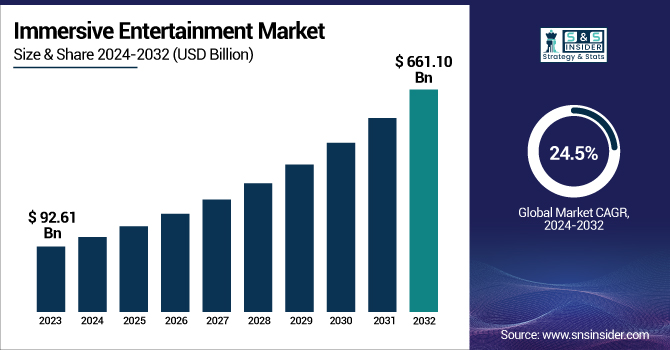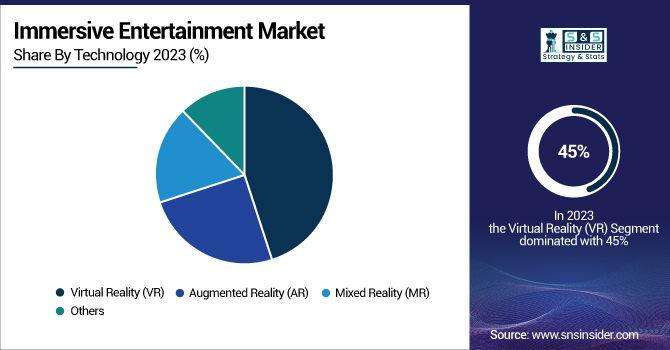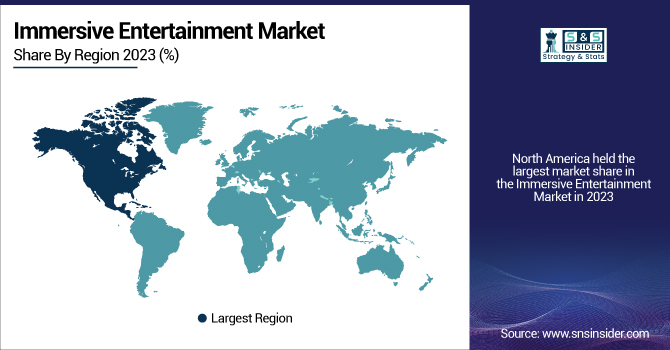Immersive Entertainment Market Report Scope & Overview:
The Immersive Entertainment Market Size was valued at USD 92.61 Billion in 2023 and is expected to reach USD 661.10 Billion by 2032 and grow at a CAGR of 24.5% over the forecast period 2024-2032.

To Get more information on Immersive Entertainment Market - Request Free Sample Report
The Immersive Entertainment Market is witnessing rapid growth due to the rising integration of virtual reality (VR), augmented reality (AR), and mixed reality (MR) across multiple sectors, including gaming, media, and live entertainment. Consumers are increasingly demanding high-quality immersive experiences, prompting major tech firms and content creators to innovate continuously. The growing availability of high-speed internet, advancements in AI-driven content creation, and the expansion of the metaverse are further accelerating market expansion. Companies are leveraging immersive technologies to enhance user engagement, with applications ranging from virtual concerts to interactive storytelling.
The U.S. Immersive Entertainment Market size was USD 26.57 billion in 2023 and is expected to reach USD 168.25 billion by 2032, growing at a CAGR of 22.83% over the forecast period of 2024-2032.
The U.S. Immersive Entertainment Market is experiencing rapid growth, driven by advancements in virtual reality (VR), augmented reality (AR), and mixed reality (MR). Increasing consumer demand for interactive and immersive experiences in gaming, live events, and digital media is fueling market expansion. Major tech companies are investing heavily in innovative hardware and content development to enhance user engagement. The rise of the metaverse, AI-driven experiences, and high-speed internet accessibility further contribute to the market’s evolution.
Immersive Entertainment Market Dynamics
Key Drivers:
-
Growing Adoption of Virtual and Augmented Reality Technologies Boosts Immersive Entertainment Market Growth
The immersive entertainment market is witnessing substantial growth due to the increasing adoption of virtual reality (VR) and augmented reality (AR) technologies across various industries. These technologies have transformed the way users engage with digital content by offering realistic and interactive experiences in gaming, live events, and digital storytelling. Companies are investing heavily in developing high-performance VR headsets, AR applications, and AI-driven immersive experiences to cater to the rising consumer demand.
Additionally, businesses in sectors like education, healthcare, and retail are integrating immersive technologies to enhance training, customer engagement, and simulation experiences. With major players such as Meta, Sony, and Apple continuously innovating and expanding their VR/AR product portfolios, the immersive entertainment market is poised for significant expansion.
Restrain:
-
High Initial Investment and Equipment Costs Restrict the Growth of the Immersive Entertainment Market
The immersive entertainment market faces a significant restraint due to the high costs associated with hardware, software, and content development. Advanced VR headsets, AR glasses, motion-tracking sensors, and haptic feedback devices often come with hefty price tags, making them less accessible to the average consumer. Additionally, the cost of developing high-quality immersive content requires substantial investment in cutting-edge technology, skilled professionals, and computing power. Small and mid-sized businesses may find it challenging to enter the market due to capital constraints and the high cost of R&D.
Furthermore, hardware limitations, such as the need for powerful GPUs, extended battery life, and lightweight designs, create barriers to mass adoption. Consumers also face added costs in upgrading their systems to support immersive experiences, which can deter widespread market penetration. While companies are working to reduce manufacturing costs and improve accessibility, the high upfront investment remains a challenge that could slow market expansion in the short term.
Opportunities:
-
Integration of Artificial Intelligence and Machine Learning Creates Lucrative Opportunities in the Immersive Entertainment Market
The integration of artificial intelligence (AI) and machine learning (ML) in immersive entertainment presents lucrative opportunities for market growth. AI-powered algorithms are enhancing the realism of virtual environments by enabling adaptive storytelling, personalized experiences, and intelligent NPC (non-player character) interactions.
For instance, AI-driven VR simulations in gaming and training applications can provide dynamic responses based on real-time user actions, making experiences more interactive. Companies such as NVIDIA and Unity Technologies are incorporating AI to optimize real-time rendering, facial recognition, and voice recognition, making immersive experiences more lifelike.
Additionally, AI-driven automation reduces the time and cost required for content creation, allowing developers to generate high-quality experiences at scale. As AI continues to evolve, immersive entertainment applications in sectors like gaming, healthcare, education, and retail are expected to become more sophisticated and widely adopted, unlocking new revenue streams and market opportunities.
Challenges:
-
Limited Content Availability and Standardization Issues Pose Challenges to the Immersive Entertainment Market Growth
The limited availability of high-quality content and the lack of industry standardization. While VR, AR, and MR technologies are advancing rapidly, content creation lags behind due to the high cost, time-consuming development, and lack of standardized frameworks. Developers often struggle with ensuring cross-platform compatibility, as different VR headsets, AR devices, and gaming platforms have unique requirements.
Additionally, content providers face difficulties in creating immersive experiences that appeal to a broad audience across multiple industries. The absence of standardized software development kits (SDKs) and frameworks leads to fragmentation in the market, making it challenging for content creators to scale their experiences across different ecosystems. This lack of consistency impacts user experience, as some applications may not function seamlessly across various hardware and software configurations.
Immersive Entertainment Market Segment Analysis
By Technology
The Virtual Reality (VR) segment accounted for the largest revenue share in the Immersive Entertainment Market, holding 45% of the market in 2023. VR has revolutionized digital entertainment by offering users fully immersive experiences in gaming, movies, live events, and simulations. Companies such as Meta, Sony, HTC, and Valve continue to dominate this space with innovative VR headsets and platforms. In 2023, Meta launched Quest 3, an advanced VR headset with improved graphics, hand tracking, and mixed reality capabilities, further enhancing user engagement. Similarly, Sony introduced PlayStation VR2, featuring 4K HDR visuals and haptic feedback for an unparalleled gaming experience.
The Mixed Reality (MR) segment is experiencing the highest CAGR of 25.0% over the forecasted period, driven by its ability to blend virtual and physical environments seamlessly. MR technology allows users to interact with digital objects in real-world spaces, creating immersive experiences for gaming, education, training, and live entertainment. Leading companies such as Microsoft, Apple, and Magic Leap are at the forefront of MR innovation. Microsoft’s HoloLens 2 continues to gain traction across industries, offering real-time holographic collaboration tools for enterprise applications.

By Application
The Gaming segment dominated the Immersive Entertainment Market in 2023, driven by the increasing demand for highly immersive and interactive experiences. The rise of VR, AR, and MR gaming platforms has transformed the industry, providing users with realistic and engaging gameplay. Leading gaming companies such as Sony, Meta, Valve, and Microsoft have introduced cutting-edge gaming hardware and software to cater to this growing demand.
Additionally, Meta’s Quest 3 and Valve’s Index VR headset are gaining popularity among gamers, providing wireless, high-resolution VR gameplay. The adoption of cloud gaming, AI-driven NPCs, and blockchain-based in-game assets is further revolutionizing the gaming landscape. Developers are integrating metaverse elements, real-time social interactions, and AI-powered customization into their games, attracting a broader audience.
The Music and Concerts segment is experiencing the highest CAGR in the forecasted period, fueled by the increasing adoption of virtual concerts, holographic performances, and immersive live events. The rise of VR, AR, and MR-based concert experiences is redefining how audiences engage with music performances. Companies like WaveXR, Meta, and Epic Games are leading this transformation by offering virtual concert platforms where fans can interact with artists in digital environments.
Additionally, Fortnite hosted live virtual concerts featuring major artists, attracting millions of viewers worldwide. The integration of AI, blockchain-based ticketing, and real-time social engagement tools is further enhancing immersive music experiences. Live Nation and Warner Music Group are exploring metaverse-based concert venues, enabling artists to reach global audiences without geographical limitations.
Regional Analysis
North America held the largest market share in the Immersive Entertainment Market in 2023, driven by early adoption of advanced technologies, strong investment in virtual and augmented reality (VR/AR), and the presence of key industry players. The region benefits from high consumer spending on entertainment, gaming, and digital experiences, making it a global leader in immersive content and hardware development. Leading companies such as Meta, Microsoft, Apple, and Sony have established a strong presence in North America, continuously launching cutting-edge VR and AR devices.
Additionally, major entertainment platforms, including Netflix and Disney, are exploring immersive storytelling and interactive experiences to enhance user engagement. The region also hosts numerous gaming studios, eSports events, and metaverse-related initiatives, further solidifying its dominance. With strong infrastructure, high-speed internet penetration, and increasing corporate investments in AI-driven immersive experiences, North America continues to lead the global immersive entertainment market.
The Asia Pacific region is experiencing the fastest growth in the Immersive Entertainment Market, with the highest CAGR during the forecast period. This growth is driven by rising demand for immersive gaming, increasing smartphone penetration, and expanding 5G connectivity across countries such as China, Japan, South Korea, and India. The region is home to leading technology companies, including Tencent, Sony, and HTC, which are actively investing in VR/AR gaming, virtual concerts, and metaverse experiences.
Additionally, Japan and South Korea are pioneers in eSports and virtual concerts, with companies like Sony and Nexon developing high-end immersive experiences. The growing popularity of XR-based training, AI-driven content personalization, and virtual social platforms is further propelling market expansion. With the increasing affordability of VR/AR devices, expansion of cloud gaming, and widespread adoption of immersive education and retail applications, Asia Pacific is set to become a major force in the immersive entertainment industry over the coming years.

Get Customized Report as per Your Business Requirement - Enquiry Now
Key Players
-
Meta Platforms, Inc. (Meta Quest 3 – VR Headset, Horizon Worlds – Social VR Platform)
-
Microsoft Corporation (HoloLens 2 – Mixed Reality Headset, Mesh – Collaborative Virtual Platform)
-
HTC Corporation (VIVE Pro 2 – High-Resolution VR Headset, VIVE XR Elite – Mixed Reality Headset)
-
Barco NV (Barco Canvas – Immersive Projection System, Barco Reality – Virtual Experience Solutions)
-
Magic Leap, Inc. (Magic Leap 2 – Augmented Reality Headset, Magicverse – Spatial Computing Platform)
-
Samsung Electronics Co., Ltd. (Samsung Gear VR – Mobile VR Headset, Samsung XR – Extended Reality Platform)
-
Apple Inc. (Apple Vision Pro – Mixed Reality Headset, ARKit – Augmented Reality Development Framework)
-
Sony Group Corporation (PlayStation VR2 – Gaming VR Headset, Sony Spatial Reality Display – 3D Immersive Display)
-
Qualcomm Technologies, Inc. (Snapdragon XR2 – Extended Reality Processor, Qualcomm Spaces – AR Development Platform)
-
Unity Technologies (Unity Engine – Real-Time 3D Development Platform, Unity Mars – AR/VR Development Tool)
-
teamLab (teamLab Borderless – Digital Art Museum, teamLab Planets – Immersive Art Installation)
-
Culturespaces (Atelier des Lumières – Digital Art Exhibitions, Carrières des Lumières – Immersive Cultural Experiences)
Recent Trends
-
June 2023: Meta unveiled Meta Quest 3, a standalone virtual reality headset featuring enhanced mixed reality capabilities and a slimmer design compared to its predecessor. Quest 3 aims to provide users with immersive experiences in gaming and entertainment.
-
January 2023: At CES 2023, HTC introduced the VIVE XR Elite, a standalone mixed-reality headset combining virtual and augmented reality functionalities. Designed for both gaming and enterprise applications, the VIVE XR Elite offers users versatile immersive experiences.
| Report Attributes | Details |
|---|---|
| Market Size in 2023 | US$ 92.61 Billion |
| Market Size by 2032 | US$ 661.10 Billion |
| CAGR | CAGR of 24.5 % From 2024 to 2032 |
| Base Year | 2023 |
| Forecast Period | 2024-2032 |
| Historical Data | 2020-2022 |
| Report Scope & Coverage | Market Size, Segments Analysis, Competitive Landscape, Regional Analysis, DROC & SWOT Analysis, Forecast Outlook |
| Key Segments | • By Technology (Virtual Reality (VR), Augmented Reality (AR), Mixed Reality (MR), Others) • By Application (Gaming, Live Events, Museum and Cultural Experiences, Music and Concerts, Sports, Arcade Studios, Immersive Theater, Others) |
| Regional Analysis/Coverage | North America (US, Canada, Mexico), Europe (Eastern Europe [Poland, Romania, Hungary, Turkey, Rest of Eastern Europe] Western Europe] Germany, France, UK, Italy, Spain, Netherlands, Switzerland, Austria, Rest of Western Europe]), Asia Pacific (China, India, Japan, South Korea, Vietnam, Singapore, Australia, Rest of Asia Pacific), Middle East & Africa (Middle East [UAE, Egypt, Saudi Arabia, Qatar, Rest of Middle East], Africa [Nigeria, South Africa, Rest of Africa], Latin America (Brazil, Argentina, Colombia, Rest of Latin America) |
| Company Profiles | Meta Platforms, Inc., Microsoft Corporation, HTC Corporation, Barco NV, Magic Leap, Inc., Samsung Electronics Co., Ltd., Apple Inc., Sony Group Corporation, Qualcomm Technologies, Inc., Unity Technologies, teamLab, Culturespaces. |

